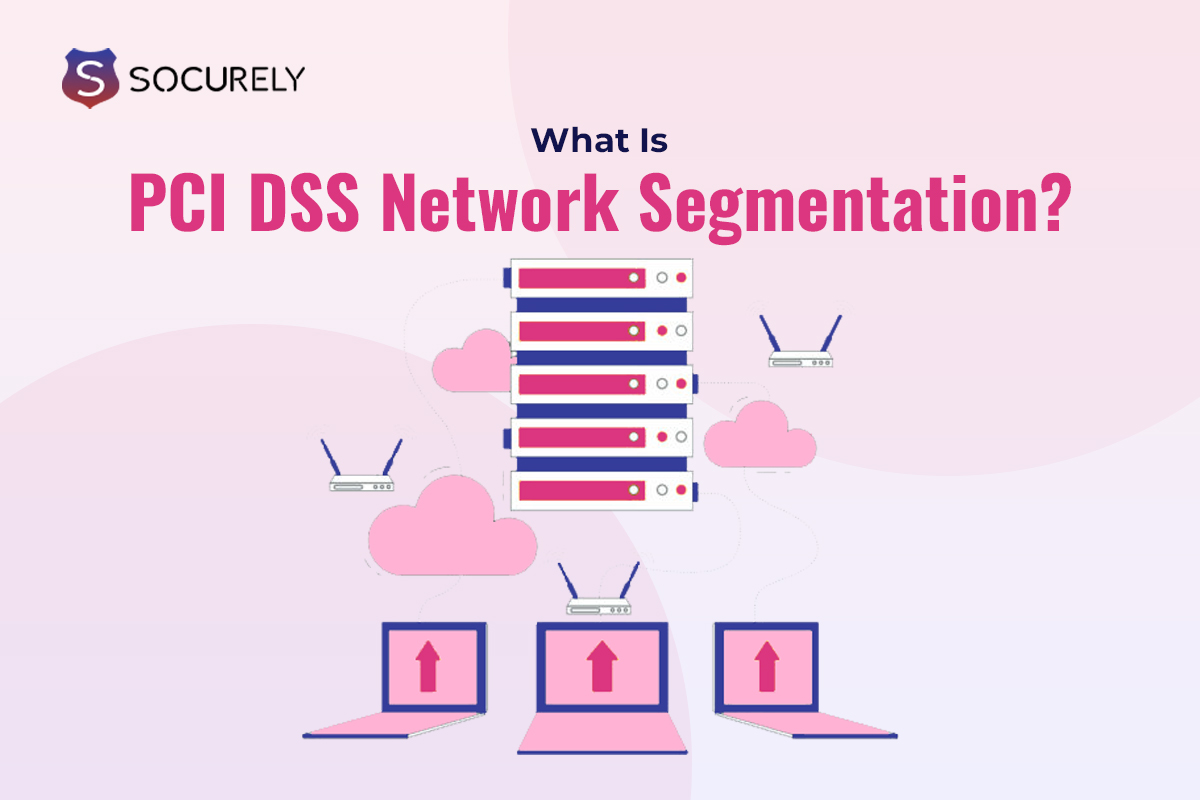Did you know that 81% of data breaches are caused by weak or misconfigured networks, many directly impacting businesses handling payment card information?
Ensuring compliance with the Payment Card Industry Data Security Standard (PCI DSS) is crucial to protect sensitive data. One of the most effective ways to safeguard your network and achieve compliance is through PCI DSS network segmentation. Network segmentation provides cloud-hosted businesses that handle credit card data with an efficient means of securing access to sensitive cardholder data. Network segmentation, which divides and isolates the networks and resources containing cardholder data, enables enterprises to prioritize and concentrate their security efforts even if it is not required by the Payment Card Industry Data Security Standard (PCI DSS).
But how does it work, and who benefits the most? Let’s find out in this blog!
What Is PCI DSS Network Segmentation?
When it comes to PCI DSS Network Segmentation, PCI DSS Scope first comes in. The three elements that make up the scope are the transmission, processing, and storage of cardholder data. Therefore, the people, procedures, and technological systems that handle, process, or send cardholder data (CHD), or credit card information, on your network are included in the scope of PCI DSS. Therefore, any information that may be exploited to steal identity or carry out fraudulent card transactions is considered CHD. According to PCI DSS, CHD is any personally identifiable information linked to a credit or debit card, such as the cardholder’s name, main account number (PAN), expiration date, service code, and sensitive authentication card information (such as CVV).
PCI DSS network segmentation is the process of isolating systems that handle cardholder data from the rest of your network. This practice limits the systems within your Cardholder Data Environment (CDE) that are subject to PCI DSS compliance, helping businesses manage risks more effectively.
Although network segmentation is not a PCI DSS requirement, it’s widely considered a best practice because it reduces the scope of PCI DSS audits and decreases the cost of compliance.
Without segmentation, your entire network could be exposed to potential threats, increasing your vulnerabilities and compliance burden. When implemented correctly, network segmentation is unaffected by an attacker gaining administrative access to a network that is beyond its scope, hence maintaining the CDE’s security. As a result, it’s an essential security tactic for businesses trying to safeguard customer information while narrowing the scope of PCI DSS compliance.
Why Is PCI DSS Network Segmentation Important?
PCI DSS network segmentation plays a pivotal role in enhancing security and simplifying compliance for businesses handling sensitive cardholder data. Here’s why network segmentation is crucial:
- Reduced Audit Scope: By segmenting your network, only systems within the Cardholder Data Environment (CDE) are subject to PCI DSS regulations. This minimizes the number of systems that need to be audited, reducing the complexity and time required for PCI DSS compliance.
- Enhanced Security: Segmentation creates a clear boundary between systems handling cardholder data and the rest of the network. This isolation strengthens your defense against cyberattacks, limiting access to sensitive data and containing potential breaches within a smaller portion of your infrastructure.
- Cost-Effective Compliance: With fewer systems in the audit scope, the costs associated with PCI DSS compliance, including security assessments and audits, are significantly reduced. Segmentation helps businesses allocate their resources more efficiently by focusing security efforts where they’re most needed.
- Improved Monitoring: Network segmentation allows businesses to focus their monitoring efforts specifically on the CDE, leading to better detection and response times in case of suspicious activity. Streamlined logging and alerting capabilities ensure quicker identification of potential threats.
- Faster Incident Response: In case of a data breach or network intrusion, having a segmented network helps contain the incident within the affected segment, allowing for a faster and more targeted response. This limits the potential damage and speeds up recovery.
- Data Access Control: Segmentation ensures that only authorized users and systems can access the CDE. This prevents accidental or malicious access to sensitive data by non-essential personnel, adding an extra layer of protection.
- Compliance Flexibility: Businesses can implement segmentation in a way that allows for flexibility when making changes or updates to parts of the network. Non-segmented systems can be modified without impacting the integrity or security of the CDE, helping organizations stay agile while maintaining compliance.
- Supports Multi-Cloud and Hybrid Environments: For businesses utilizing cloud-based or hybrid environments, PCI DSS network segmentation is essential to separate on-premise systems from cloud-based systems. This ensures that data is kept secure across all platforms, regardless of where it’s stored or processed.
- Minimizes Risk of Insider Threats: Segmentation helps reduce the risk of insider threats by limiting access to sensitive areas of the network. Employees or third-party users who don’t require access to cardholder data can be restricted from entering the CDE, lowering the chances of accidental or intentional data breaches.
Third-Party User Segmentation and PCI DSS Compliance
With businesses increasingly relying on third-party vendors and cloud services, ensuring third-party user segmentation becomes vital for PCI DSS compliance. By segregating third-party access from your CDE, you prevent vendors from inadvertently accessing or compromising sensitive data. This ensures that third-party users only access the systems they need, safeguarding your network and maintaining PCI DSS standards.
Some examples to consider-
- Third-party service providers who handle the processing, storing, and/or transfer of your CHD, including companies that handle customer contact and call centers, e-commerce payment processors, and processing gateway companies.
- Businesses that offer secure destruction of physical and electronic media, firms that encrypt or tokenize cardholder data, and third-party software providers for e-commerce and mobile applications are just a few examples of organizations that are involved in protecting cardholder data.
- POS firms that handle their systems’ setup, upkeep, supervision, or support.
- Entities that handle cardholder data and CDE security include managed firewall/router providers and monitoring services for intrusion-detection systems (IDS) and other key security alerts.
- Companies that offer software development services, managed IT delivery channels and services, and maintenance services (such as HVAC or cleaning) are examples of organizations that can have accidental access to CHD or the CDE.
What Best Practices Are Involved in PCI DSS Network Segmentation?
Implementing network segmentation effectively requires adherence to several best practices, including:
- Identify Your CDE: Clearly outline which parts of your network handle cardholder data.
- Implement Firewalls and Access Controls: Use firewalls, VLANs, and access control lists (ACLs) to segregate sensitive systems.
- Use Multi-Factor Authentication (MFA): Apply MFA to secure access to the CDE.
- Monitor Network Traffic: Continuously monitor and log network activities to detect any suspicious or unauthorized access.
- Regular Updates and Patches: Keep your systems, especially those within the CDE, up to date with the latest security patches.
Who Benefits from PCI DSS Network Segmentation?
Businesses that process payment card data benefit from PCI DSS network segmentation, particularly:
- Retailers and e-commerce platforms handle thousands of transactions.
- Financial institutions with vast stores of sensitive payment information.
- Healthcare organizations managing patient payment details.
- Hospitality industries, including hotels, travel agencies, and restaurants process card payments.
For these industries, segmentation not only boosts data protection but also simplifies compliance and reduces operational costs.
How Socurely Can Help With PCI DSS Network Segmentation?
At Socurely, we recognize the intricacies involved in achieving effective PCI DSS network segmentation. Our team of compliance experts delivers tailored solutions to help businesses safeguard their cardholder data, reduce audit scope, and maintain compliance. We offer customized assessments, firewall configuration services, and continuous monitoring to ensure your network remains secure and meets PCI DSS requirements. Whether you’re starting from scratch or refining an existing segmentation strategy, Socurely can guide you through every step of the process, ensuring your business is protected from potential threats while staying compliant.
Conclusion
Whether you’re handling third-party vendors or managing internal systems, PCI DSS network segmentation is a critical component of securing your data. It not only reduces risks and cuts compliance costs but also simplifies audits and enhances your network’s overall security.
Ready to safeguard your payment systems and achieve seamless compliance? Contact Socurely today for a comprehensive PCI DSS network segmentation solution that fits your business needs.







